Simplicity Coimbatore ,amaranth leaves </a
There’s one plant which grows like wildfire all around our home. It grows in corners pushing past sharp pebbles , against the wall near the bougainvillea climber and even in grow bags wherever there is space between the coriander or mint or basil ! This is probably a good reason why I have continued to take this invasive thandu keerai for granted!
Whenever we are uncertain about what other poriyal to cook, it’s usually the thandu keerai which gets unceremoniously pulled out and cooked. I know that we should treat it with as much care as we do the rest of the kitchen garden but I suppose that’s the attitude most of us have for something which comes easy without having to work for !
While this thought process may resonate with other aspects of daily life, this post is actually just about today’s green in focus, the thandu keerai also known as Amaranth. Though we did cook this often , it wasn’t until a friend from Europe asked me for Amaranth leaf powder to add to her morning smoothie,that I actually paid closer attention to this ingredient.
Just like how we have a huge amount of native greens in India, the Amaranth family of plants are of many kinds. In fact if you check Wikipedia ,it says , “Amaranthus is a cosmopolitan genus of annual or short-lived perennial plants collectively known as amaranths. Some amaranth species are cultivated as leaf vegetables, pseudo cereals, and ornamental plants. Most of the Amaranthus species are summer annual weeds and are commonly referred to as pigweeds”
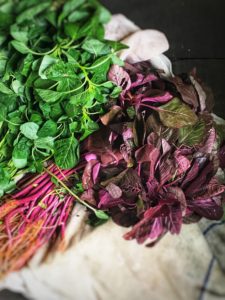
See !…even Wiki calls it a “weed” so my oversight can be pardoned! The amaranth plant has it’s origins in Central America where the seeds are consumed in grain form. Amaranth seed flour is widely available. Callaloo is a famous dish made in the Caribbean islands using native greens.Amaranth leaves are one of the leaves used in this dish.
Our local stores and small petty shops do have tiny packets of the amaranth seed (ladoo) balls. The edible variety of amaranth leaves comprises of many colours. While in the South we do have the green and almost bright pink to purplish red leaves, up North they do have the more yellow to golden coloured amaranth variety as well, growing closer to the foothills the Himalayas.
Here in Coimbatore we simply refer to it as Thandu keerai or sivappu thandu keerai (red variety). Edible greens are at their freshest when the parched earth receives some rainfall. The stalks spring up in no time and the ground is covered by a vibrant canopy of leaves. If you have seen a keerai patch you will understand what I mean.
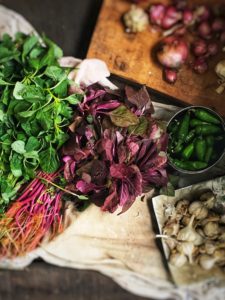
It is no coincidence that a diet of greens is highly recommended during the monsoons. Native varieties of spinach are choc-a –bloc with minerals and vitamins which are essential for the season . Nutrition pertaining to amaranth leaves are well documented in these two articles for which I am sharing the links;
https://food.ndtv.com/food-drinks/amaranth-leaves-how-to-cook-this-green-leafy-vegetable-761205
Interestingly these articles also draw a comparison to Kale which is now a much sought after green in the urban diet. While the amaranth leaves may not possess the similar culinary characteristics to the crinkly kale leaves,nutritionally ,they are a far better for absorption and assimilation with regards to the Indian metabolism.
We have so many recipes when it comes to cooking the amaranth leaves. These leaves are rarely ever eaten raw. Yet Western recipes and other Asian cuisines do recommend adding the tender leaves in raw form to salads. The reason why this is referred to in Tamil as Thandu keerai is because the stalks supporting these leaves are particularly fibrous and thick making it hard to chew and digest. The leaves are painstakingly removed from the stalk and treated to all manners of cooking depending on which part of the country the recipe originates from.From a thotta koora pappu to a kadanja keerai to creamed spinach on toast , we Indians do come up with many recipes for our greens.
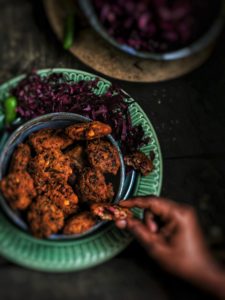
Recently we decided to use the red amaranth leaves to make the much loved keerai vadai. The window pane was being splattered incessantly with raindrops, the skies had darkened and we were delighted that we had foreseen this weather and had made the lentil batter ahead of time. Soaked and cooked lentils when combined with spices ,onions , salt and finely chopped spinach leaves makes for delicious lentil fritters when deep fried in hot oil. Lentil and spinach fritters sound fancy but try a bite of a crisp ‘Keerai vadai ‘ and it’s unlikely that you will ever forget the name of this south Indian snack !
A keerai vadai is best enjoyed with some piping hot tea. While I do like a weak tea with little milk, this one demands a milky , masala infused chai ! And rain it did,as if on cue. The azure coloured glazed plate from a local pottery studio piled generously with the hot , tasty vadai looked, tasted and felt so good. There is indeed a connect between fried food and rainy days which helps in uplifting the spirits !
We also made another simple dish using the red amaranth leaves.It’s called Tamdi bhaji (recipe coming soon)and the recipe has it’s origins in Goa. What I liked best about it was that the flavourings for this dish were so familiar to our South Indian palate. Sautéed onion and garlic pieces , salt , turmeric, red chilli powder and lots of freshly grated coconut added to the sivappu thandu keerai . The coconut helps in pushing the taste buds more towards the sweet than to linger onto any bitterness released by the leaves. It resulted in a tasty sauté which went well with rasam saadham .
The fresh green thandu keerai was not to be ignored and we cooked it promptly the next day with samll onions, green chillies,garlic cloves , the mandatory tablespoon of ghee,asafoetida and cumin. It was feasted on heartily thereby finally giving it the due recognition it deserved.
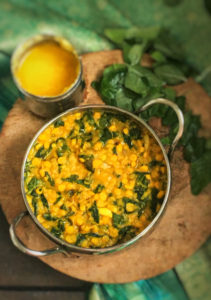
Recipe to follow
How much we take our cuisine for granted. As I look out my kitchen window I can see the tall stalks of the aged green amaranth, the seeds ready to scatter in the wind and right beside are the new greens ,waiting to shoot up towards the sky bearing the grey clouds, heavy with the promise of more rain.
I make a mental note to include these ,not just healthy ,but delicious greens more frequently in our diet. The thought of discovering new recipes and sharing them is what brings the most joy !
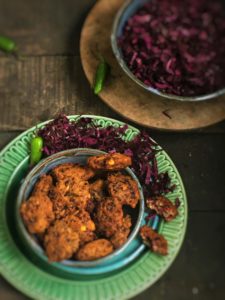

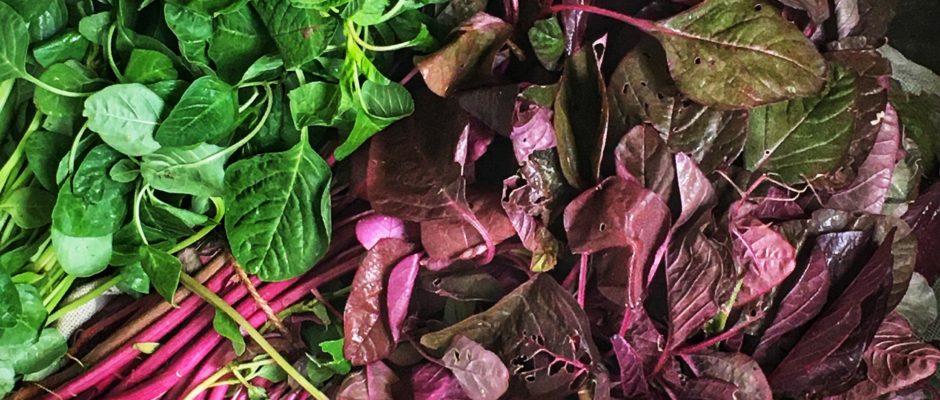
ANy prticular reason why amaranth leaves are not or should not be eaten raw?
Ayurveda always believes that food intake should be in a form which can be digested easily. Raw amaranth leaves may not be as easily absorbed and assimilated as cooked greens